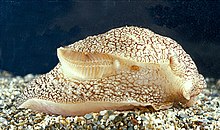Ctenidium (mollusc)

A ctenidium is a respiratory organ or gill which is found in many molluscs. This structure exists in bivalves, cephalopods, Polyplacophorans (chitons), and in aquatic gastropods such as freshwater snails and marine snails.[1] Some aquatic gastropods possess one ctenidium known as monopectinate and others have a pair of ctenidia known as bipectinate.
A ctenidium is shaped like a comb or a feather, with a central part from which many filaments or plate-like structures protrude, lined up in a row. It hangs into the mantle cavity and increases the area available for gas exchange.[2] The word is Latinized but is derived from the Greek ktenidion which means "little comb", being a diminutive of the word kteis meaning comb.
-
 Pair of large, grey gills visible inside the mantle cavity of a giant squid
Pair of large, grey gills visible inside the mantle cavity of a giant squid
References
- v
- t
- e
- Callus
- Hinge line
- Hinge teeth
- Ligament
- Lira
- Lunule
- Nacre
- Pallial line
- Pallial sinus
- Periostracum
- Prodissoconch
- Resilifer
- Resilium
- Sculpture
- Umbo
- Valve
- Beak
- Annuli
- Adductor muscles
- Ctenidium
- Gastric shield
- Mantle
- Nephridium
- Siphon















